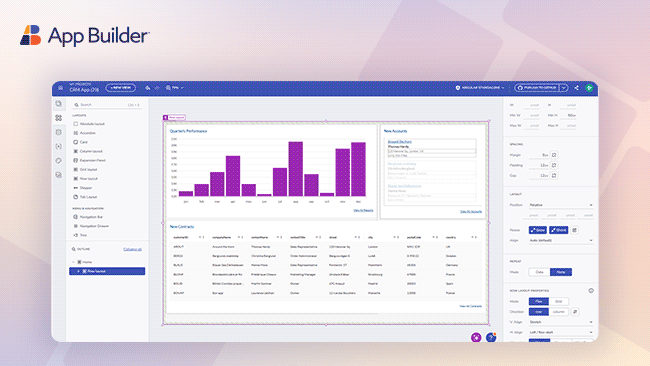
Builder.ai Shuts Down: Here’s a Reliable Alternative to Keep Your App Project Alive
What happens when you're stranded with half-finished apps because the development tool you've been using is suddenly no longer available? Or when you cannot even access your in-progress apps on the platform? How do you manage and compensate for the lost investments, the waste of time and effort, and, eventually, the stagnated innovation process?
Yes, this is a scenario that has happened recently with Microsoft-backed Builder.ai, which collapsed and left organizations, startup founders, entrepreneurs, and non-technical product owners in limbo. Once valued at a staggering $1.5 billion, Builder.ai went into bankruptcy after it became evident that it passed off human-written code as AI-generated. Consequently, that triggered global layoffs, regulatory scrutiny, and audits.
So, what’s the Builder.ai alternative that companies have?
The Story: An AI-Breakthrough or Just 700 Engineers Behind the Curtain?
Previously known as Engineer.ai, Builder.ai was launched in 2016 as a no-code, AI-powered app development platform by Sachin Dev Duggal. Headquartered in London, the high-flying startup aimed to reinvent the way people build software, and it quickly attracted investments from industry giants such as Microsoft, SoftBank’s DeepCore, and others.
The biggest innovation they marketed as a breakthrough was their AI assistant, Natasha, which could easily develop apps on its own with minimal hand-coding. However, the truth was that behind the tool, there was a human power of 700 engineers based in India. Instead of generating code with AI, they wrote code manually for their clients’ projects.
Once considered a promising player in the no-code/low-code app development landscape, Builder.ai began to crack when industry observers and internal investigators began winding down operations, revealing underlying issues and an ongoing deception. In a LinkedIn post, Linas Beliūnas of Zero Hash accused Builder.ai of fraud, publicly claiming that: “It turns out the company had no AI and instead was just a group of Indian developers pretending to write code as AI.” The public havoc was also stirred up by further scrutiny that uncovered significant financial irregularities and revenue manipulations.
For instance, an internal audit revealed that Builder.ai’s sales figures had been artificially inflated by as much as 300%. Bloomberg uncovered a round-tripping scheme involving the Indian social media company VerSe Innovation, where both organizations exchanged nearly identical invoices between 2021 and 2024, totaling millions of dollars for bogus sales and services that were never actually delivered. Ultimately, it was revealed that Builder.ai’s real 2024 revenues were $55 million—just a fraction of the $220 million figure previously projected to investors.
A Critical Blow to Momentum: What Builder.ai’s Collapse Means for Users?

The sudden shutdown of Builder.ai isn’t just a technical issue. For startup founders and small organizations, this is beyond inconvenient. It’s a serious setback that delays their business momentum, disrupts fundraising timelines, derails product roadmaps, and hinders go-to-market strategies. For non-technical users, it highlights the risk of relying on platforms that don’t provide full dev control over apps and lack long-term support.
Lost Access and Restricted Apps
Many users have lost access to in-progress applications, with no clear way to recover their code or continue development. This means months of work and investment may be gone along with the ability to meet critical launch or funding milestones.
Concerns About Vendor Lock-In and Data Portability
Builder.ai’s closed platform left users without access to their source code or backend infrastructure. With no way to export or migrate, many found themselves entirely dependent on a system that no longer exists—a painful reminder of the risks behind black-box, no-code promises.
The Bigger Risk: Unsustainable Platforms
There is a broader warning that this turn of events sends to the developer community and companies worldwide: relying on venture-backed tools without long-term sustainability is risky. When platforms are built on hype and inflated metrics rather than transparency and real value, users are the ones who pay the price. Reliability, not just features, should be the foundation of any development tool.
Enter App Builder: A Reliable Alternative You Can Trust
Now, developers, founders, and product teams need more than a quick fix. They need a trustworthy, scalable, and transparent solution to continue (or recover) their app development journey. App Builder steps in as a proven Builder.ai alternative. It doesn’t just offer similar features; it does so with a fundamentally different approach.
Whether you’re a startup founder rebuilding a paused MVP, a non-technical business leader seeking clarity, a no-code creator who wants streamlined development without hand-coding, or a larger organization needing a platform with long-term stability, our low-code tool is designed with full code ownership, deep customization, and no vendor lock-in risks.
Using a common app model, App Builder can easily generate production-ready code for the most popular web frameworks, including Angular, React, Web Components, and Blazor. What’s the most significant benefit here? The tool describes apps in a framework-agnostic way, letting users build and switch applications from one technology to another, matching requirements with ease.
Who Is App Builder For?
- C-level executives, enterprise architects, and other stakeholders whose goal is to achieve digital transformation faster, replace legacy systems, drive business growth, and achieve faster time to market.
- Startup founders and entrepreneurs who need to rapidly build, iterate, and scale apps without sacrificing transparency or ownership.
- Developers and dev team leaders who need a flexible, WYSIWYG low-code platform that doesn’t limit them with proprietary functionality or have hidden costs.
- Companies and teams that want predictable development, full access to source code, and sustainable growth beyond an MVP.
What Makes App Builder Different
App Builder is a low-code platform committed to giving users real control over their software, along with transparency and long-term value. Here are the most significant benefits it offers:
Full Code Ownership
App Builder ensures developer freedom, deep customization, and access to the underlying code. That means teams and enterprises can easily:
- Migrate projects if needed, edit the code upon generation, and own the code.
- Switch between platforms with ease, thanks to framework-agnostic components and code generation for Angular, React, Web Components, and Blazor.
- Work with external teams and citizen developers at any stage.
Transparent Pricing
You get transparent and flexible pricing without hidden costs. Whether you’re building a prototype or a full-scale platform, you’ll know exactly what you’re paying for.
No Vendor Lock-In
App Builder doesn’t restrict you to proprietary infrastructure or hidden dependencies. It leverages widely accepted technologies and data formats. Moreover, developers don’t have to give up functionality. They offer full control, open standards, code preview, and code generation, as well as seamless integration, rich APIs, compatibility with external tools and services such as GitHub and Reveal, and support for data integration.
Other benefits include:
- An intuitive drag-and-drop development experience with 65+ high-performing UI components that are easy to customize (including grids, charts, and more).
- AI-driven capabilities with App Builder AI for views, images, and data source generation based on plain language prompts.
- Multiple layout options, data binding, routing and navigation, theming and branding, and more.
- Developer-first experience with tutorials, how-to guides, comprehensive documentation, and strong support networks.
- An easy and transparent way to export your app as a zip file or a GitHub repository.
- The ability to build data-rich HR dashboards, content management systems, E-commerce platforms, customer portals, learning portals, CRMs, inventory management apps, and others.
- Commitment to security protocols and compliance with industry standards.
- Long-term human support and a clear roadmap, continuous updates, community-driven improvements, and a vibrant developers’ community.
App Builder vs Builder.ai: Side-by-Side Comparison
The table below depicts the difference between App Builder and Builder.ai. Note that the advantages of the latter are those considered before the actual truth about the tool was revealed. The goal of the comparison is to highlight that App Builder can easily be the ultimate Builder.ai alternative, providing more features, components, and capabilities.
| App Builder | Builder.ai | |
|---|---|---|
| Code Generation | Marketed as AI-generated | |
| Full Code Ownership | ||
| AI Functionality | ||
| Vendor Lock-In | No Vendor Lock-In | No Vendor Lock-In |
| Platform Sustainability | ||
| Using & Handling Data |
|
|
| Converting Designs to Code |
|
|
| Deep Customization |
|
|
| Simple Integration with Third-Party Apps |
|
|
| Support | ||
| Transparent Licensing | ||
| Use Cases | Enterprise-grade apps, MVPs, POCs | Mostly MVPs and prototyping |
Wrap Up
The collapse of Builder.ai serves as a reminder that sometimes chasing “AI-driven magic for quick fixes” and tech unicorns results in costly setbacks, stagnated innovation, and maybe even years of lost hard work on projects. What seemed like an innovation shortcut turned out to be an inflated tech delusion with no substance, compromised credibility, a lack of actual transparency, and one of the biggest software frauds of the year. With such a wake-up call, what’s the next move? What does this mean for development teams, businesses, executives, and no-coders who seek innovative approaches?
It means they have to reconsider things like:
- Transparency in technology claims
- Financial and reporting integrity
- Vendor reliability
- Data ownership and portability
- Regulatory and legal scrutiny
- Long-term viability
This is precisely where App Builder steps in, offering feature parity, code generation, code preview, AI functionality, deep customization, transparency, security, and no vendor lock-in.


